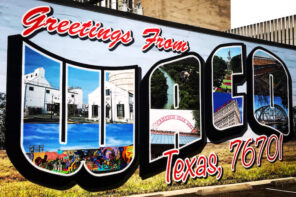With the 25th anniversary of the Waco disaster behind us, and the 40th anniversary of the Jonestown tragedy ahead, journalists, filmmakers, and documentarians have been scrambling this year to capitalize on popular interest in sex, cults, and violence. At least seven documentaries and a dramatic miniseries have come out about the Branch Davidians, while more than a half-dozen programs on Jonestown and Peoples Temple have aired or are currently in the works.
The latest offering is ABC’s “Truth and Lies: Jonestown, Paradise Lost,” slated to air this Friday, September 28. A January episode of “Truth and Lies” featured the Branch Davidians. Muriel Pearson, a senior producer at ABC News, created both programs.
Documentaries that come out of news departments are no less sensationalistic than those developed by independent producers. There is one key difference, however: network news departments tend to avoid creative re-enactments—that is, dramatizations of events for which actuality footage is lacking. This was the case with NBC Dateline’s episode on Jonestown, which relied entirely upon archival footage and interviews with participants, rather than re-creations, to tell the story of what happened in November 1978.
The reputation of news departments, in fact, depends upon the truthfulness of what viewers are seeing. That’s not necessarily the case with independent filmmakers.
Ever since the 1920s, when filmmaker Robert Flaherty directed Inuit actors—paid for by the Revillon Frères fur-trading company—to portray a “typical” Eskimo family living in the far north, documentary producers have had a squishy relationship with the truth. This stems from the fundamental question of who, or what, documentarians are: News reporters, arranging facts in a coherent order? Advocates, promoting a particular position? Auteurs, creating narratives that have dramatic highs and lows?
As media scholar and critic Brian Winston persuasively argues, documentaries are not newsreels or travelogs, and documentarians have almost always written scripts, directed participants, and edited shots for dramatic effect. (Fred Wiseman or the Maysles brothers might be exceptions to this rule.) Indeed, filmmakers ought to tell the truth as they see it; otherwise, according to David Richter, they are mere publicists.
Documentaries are artificial constructs which, in a post-modern environment that blurs the line between fact and fiction, should not disturb us. Two factors that were largely absent in the past, however, have changed things.
First is the pervasive claim that any and all news with which we disagree is “fake.” Thus, re-enactments or dramatizations that are not identified as such raise legitimate questions about filmmakers’ intentions. Case in point: when Cineflix Productions re-created the death scene in its History Channel documentary “Jonestown: Paradise Lost,” the producers took a decisive stand on what has become a contested issue.
The second factor concerns representations of religion, especially minority religions or alternative groups following unconventional lifestyles that seem to violate social norms—living communally, accepting voluntary poverty, rejecting immediate family, practicing sexual sharing, or other activities. Filmmakers are then faced with the choice of depicting the group from within its own viewpoint (the emic position) or of presenting it as outsiders (the etic stance).
The directorial team of Chapman and Maclain Way juggled these two perspectives quite well in their 2018 documentary about Rajneeshpuram, “Wild Wild Country.” The six-part series revealed the escalating conflict between the residents of Antelope, Oregon and the followers of the guru Bhagwan Shree Rajneesh. Viewers could well understand the concern that locals had about the influx of thousands of newcomers, but they could also appreciate the frustration the Rajneeshees experienced as they attempted to construct a large religious community in a sparsely populated area.
In addition, the difference between re-enactments and reality footage was crystal clear. The Way brothers utilized animated sequences to portray discussions for which they had no film. There was no mistaking what was real and what was reconstructed.
In contrast, the A&E documentary “Jonestown: The Women Behind the Massacre” that aired last February, obscured the line between fact and fiction sufficiently to confuse some viewers.
Both programs used stock footage of events that may, or may not, have represented the actual events under discussion, but that’s a separate issue. The use of stock footage has a venerable tradition. From shots of a priest consecrating the host to scenes of a congregation singing praise hymns, stock footage is a staple in documentary production. We don’t usually have an ethical problem with this creative device, since we know that it keeps the story, and action, moving.
But stock footage has its drawbacks as well. After a preview screening of Stanley Nelson’s award-winning documentary, “Jonestown: The Life and Death of Peoples Temple,” an audience member asked the director how he’d gotten the footage of people lining up to drink the poison in Jonestown. Nelson had to admit that the images he’d shown were of people waiting in line to get supper, not cyanide.
None of these issues occurs with docudramas or biopics—that is, explicitly fictional portrayals of historical events or personages. Sikivu Hutchinson’s short film “White Nights, Black Paradise,” for example, creatively imagines life for African-American women in Peoples Temple. We willingly accept the construction of composite characters, the compression of time, the rewriting of historical speeches, and the creation of dialogue. Moreover, sometimes docudramas capture the truth of events in ways that elude more traditional documentaries.
This is the case for the Paramount Network’s miniseries on “Waco” that aired earlier this year. The episodes flesh out the personality of Branch Davidian leader David Koresh (portrayed by Taylor Kitsch), and make his charisma understandable. John Erick Dowdle and Drew Dowdle, the co-creators, also show the conflict that occurred between the FBI negotiators and the FBI hostage rescue team. The fact-based programs about Waco, on the other hand, tended to adopt a tabloid-style approach to a complicated subject.
We don’t expect the HBO fictional miniseries “Welcome to Jonestown”—from “Breaking Bad” producer Vince Gilligan—to be quite as nuanced, if the opening credits are any indication of its direction. Production on that series isn’t scheduled to begin until 2019.
Meanwhile, the Sundance Channel will air a two-part documentary “Jonestown: Terror in the Jungle,” based on Jeff Guinn’s biography of Jim Jones, to coincide with the November 18 anniversary of the tragedy. And a documentary series from CNN is in the preproduction stages. Both Sundance and CNN plan to incorporate dramatizations into their programs.
Our understanding of what documentaries should and should not do has changed in the near-century since Robert Flaherty pioneered the genre. There’s no consensus over ethical obligations, however, so documentarians are free to be characters in their films, to re-create events or enhance archival footage, to stage conversations with actual participants, and more. This creates a problem in differentiating between what’s real and what isn’t.
At the very least, I would hope that re-enactments in factual programs would be clearly identified. The Producers Handbook for Channel 4 in the United Kingdom states that:
“The use of a dramatic reconstruction, sometimes involving real people rather than actors, is a perfectly acceptable technique, provided viewers are not misled and clearly understand or are informed, for instance, by labeling on screen or in voice over, the true nature of what they are seeing. Reconstructions must not, however, distort the known facts.”
It’s bad enough that we flippantly observe that someone is “drinking the Kool-Aid,” without regard to the origins of the expression in the deaths at Jonestown.
But faking the Kool-Aid in re-enactments goes even further, turning religious tragedies into cheesy melodramas. Seeing, therefore, should not necessarily be believing when viewing the current crop of programs. Caveat Observator.




